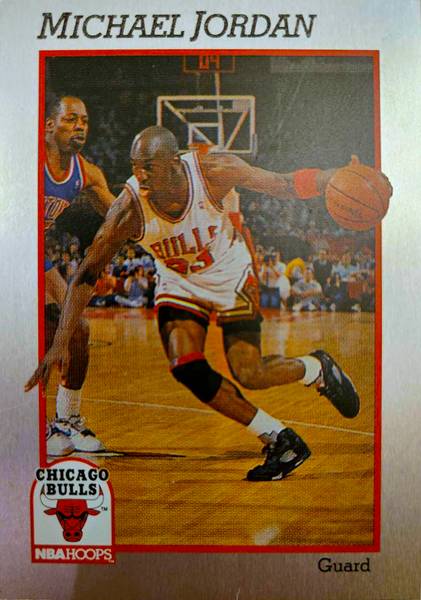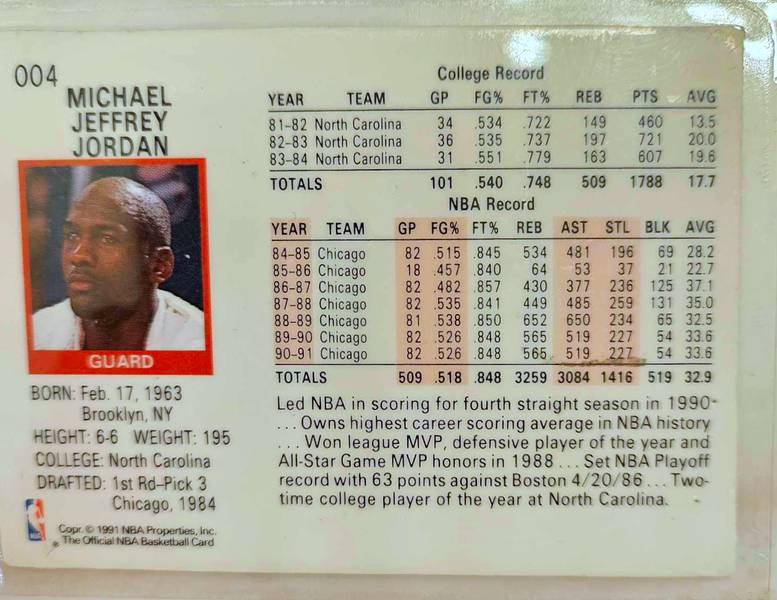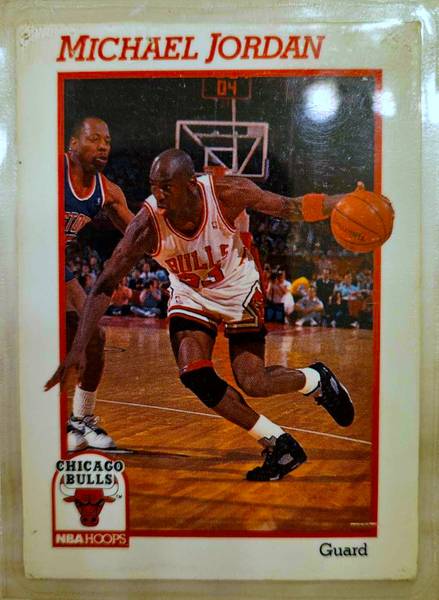Simple offset printed 2.5 x 3.5-inch cardboard was all you got if you were a collector of basketball cards through the 80’s. There was no foil, hologram, chase insert or die-cut cards we love nowadays - just a card per player in neatly organised sets - sometimes even arranged by team - along with a star player sticker from a limited set in Fleer packs. Not even every player was included - famously Stockton in missing from 86-87 Fleer as is Robinson from 89-90 Fleer.
Robinson’s rookie season - presumably missed in 89-90 Fleer due to his Navy commitments - is thankfully captured by Fleer’s first real competition in the basketball card market ever: Hoops. The two companies would be joined shortly thereafter in the marketplace by Skybox (1990), Upper Deck (1991) and Topps’ return (1992).
This new level of interest in basketball cards, along with the increased competition and improvements in printing, led to a need to differentiate. How could trading card companies set themselves apart to entice consumers? Innovation was key in this is the period of healthy competition and consumers would be the beneficiaries.
As the newcomer to the market, Hoops needed to set itself apart from market embedded manufacturer Fleer and the emerging competing manufacturers.
The prototyping that would follow would include somewhat of a ‘Big Foot’ in the basketball card world - in the same arena as the Lake Tahoe and SP Holoview McDyess background Jordan cards - will you ever get to see one?
TL;DR - a quick look at the 1991 Hoops Prototypes
Here's the three cards we're looking at for this article.
Partnering with a bread producer
The idea was to enter into a partnership with a producer of a household staple. This would, both, reach new markets and incentivise purchasing the product - win/win for Hoops and the product manufacturer.
In the same vein as Jordan’s Upper Deck partnership with Hanes in 2018, Hoops’ specially produced cards could be obtained upon purchase of specified bread products.
This was a time of several partnerships for Hoops. There are sets available from partnership with Sears, McDonalds, Safeway and a Larry Bird VHS among others.
Further to the partnership, as we’ll see below, there was consideration that these cards could also be obtained via specially inserted redemption cards by buyers of packs of Hoops products.
As an interesting aside this wasn’t going to be a first for Jordan - technically speaking. Portland based Franz bread had been distributing cards alongside their products for some years in support of their local NBA team the Portland Trail Blazers. Michael Jordan can be seen in shadow in two cards: the 91-92 Terry Porter and 91-92 Jerome Kersey.
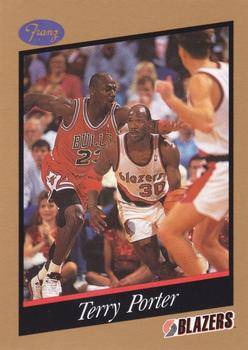

1991-92 Hoops Prototypes
As a prototype for the 1991-92 set, Hoops created a sample 10-card set numbered 001 to 010. The set features 10 of the top stars of the early 90’s NBA - in fact it is essentially a who’s who of the 1986-87 Fleer rookie class. Jordan features at number 004 and Malone and Johnson are featured on two cards: base and All-Star subset.
These cards have the word ‘PROTOTYPE’ printed over the top of the player biography to the bottom of the card reverse.
Here is the checklist for the cardboard prototypes produced.
| # | Player | Subset |
|---|---|---|
| 001 | Clyde Drexler | |
| 002 | Patrick Ewing | |
| 003 | Magic Johnson | |
| 004 | Michael Jordan | |
| 005 | Karl Malone | |
| 006 | Hakeem Olajuwon | |
| 007 | Charles Barkley | All-Star |
| 008 | Magic Johnson | All-Star |
| 009 | Karl Malone | All-Star |
| 010 | Dominique Wilkins | All-Star |
I mentioned innovation earlier - this is where the Hoops aluminium cards join the story.
We’re not sure exactly whether it would be the Jordan card alone or a multi-card set but the plan was to create aluminium printed cards as those available to buyers of the bread products.
Aluminium cards are something which had never before seen in trading cards and would certainly set Hoops apart in the collecting community at the time. Only the Jordan card was prototyped in aluminium and does not include any ‘PROTOTYPE’ designation as used on the cardboard version.
Finally, there is a third version of these cards - a cardboard #004 Jordan was produced without the ‘PROTOTYPE’ designation as per the metal variation. This card could very well be the rarest as we will discuss below.
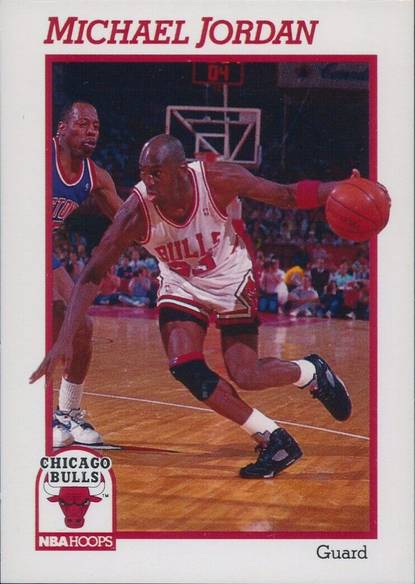


A first-hand account of a Print Manager
For this dive into the Hoops prototypes we have a special guest sharing his story publicly for the first time. Leo Anderson was the manager of the print shop which Hoops used to develop their metal prototype - though long since retired, he remembers the time well.
So, join Leo and I for a journey back to the early 90’s as he shares his story of a couple of experiments never before seen in trading cards.
GM Nameplate metal prototype
Who do you turn to when you’re innovating the cardboard out of basketball cards? Well, in this case, Hoops turned to internationally renowned sign manufacturing experts GM Nameplate.
GM Nameplate - since acquired by Boyd and known for creation of specialty pieces (including all signage on many Boeing aircraft) - could bring Hoops’ plan to life. Leo Anderson had been with the organisation as a long term employee in the midst of his 34 year tenure and was hands-on throughout the entire Hoops prototyping process.
Leo explained the attraction that kept him at GM for 34 years - “there was always something different… like this Michael Jordan card”.
Working out of their Seattle plant, Leo and his team began by applying GM’s proprietary treatment to the metal sheets so they would accept the ink. The sheets were then fed through a specially modified Heidelberg Press (modified to accept heavier stock) where a four-colour printing process took place.
Hoops’ artwork was printed onto the prepared metal sheets using a UV ink printing process. A UV reactor dried the ink allowing stacking of the sheets. Once the printing was complete a final protective topcoat was applied.
Leo notes that quality control was important for Hoops. “They didn’t want to go through this process and have customers receive their cards only to have the centering all over the place”. So, GM used a shearing technology from Spartanics which could deliver the perfect results required. Thus, any MJ metal prototype should have perfect centering and edges out of the press.
Michael Jordan Hoops Prototype Metal print run
The cards were printed on a sheet of aluminium which would yield four cards per sheet. As Leo recalls, “less than 50 sheets were printed… and even that is a lot for a prototype”.
So, we can verify by first-hand account that no more - and likely less - than 200 of the MJ metal prototypes were printed.
Leo recalls that at least one sheet was left uncut at the time which would further reduce the population of individual cards. An uncut sheet of these already incredibly rare cards would be an amazing piece to see.
Leo’s artefacts of the time
As manager of the print shop, extra pieces would often end up on Leo’s desk. He explained it was some time before a few of the metal prototypes that sat on his desk headed home with him. Currently he owns one recently graded SGC 9 and two raw copies.
In addition to the metal prototypes, Leo has a copy of the cardboard prototype without the ‘PROTOTYPE’ designation on the reverse which was gifted by Hoops’ representatives. Leo’s non-prototype cardboard copy was laminated at the time and remains so today. Per his memory, Hoops had produced few of these cards as they were intended only for reps to carry and not for distribution to dealers. The cards with ‘PROTOTYPE’ were intended for dealer distribution at major card shows to share a glimpse of the upcoming release by Hoops.
These cards all feature the same design and photo - a classic Jordan tongue-out drive.
Speaking of the photo - Leo recalls hearing within GM that Jordan’s team was not happy with the photo used by Hoops. Being a classic Jordan tongue-out drive it was likely too heavy on the Jordan brand to be used on a trading card. As I’ve looked at before, we know that this Hoops prototype was the last trading card to feature Jordan with his tongue out as those photos were reserved for official Jordan brand products.
This was to be just the beginning
Not commonly known is the fact that Hoops were considering continuing these metal cards into future products. Leo’s team was involved in the early stages of prototyping a second metal card. This set would have also been available as a redemption in Hoops products and may have been part of a continuing product partnership.
Hoops had been the only manufacturer to capture David Robinson’s rookie card so who better to choose than The Admiral for a second release of the metal cards?
The artwork for Robinson’s Rookie-Of-The-Year Hoops card from the 90-91 set was sent to Leo and his team at GM Nameplate. They got to work to prototype this card creating a black printing plate and running a prototype in black ink of the front alone. Unfortunately, the project was halted by Hoops before any further progress was made on the David Robinson metal card.
Leo owns a copy of the black ink metal Robinson card which is shown here.
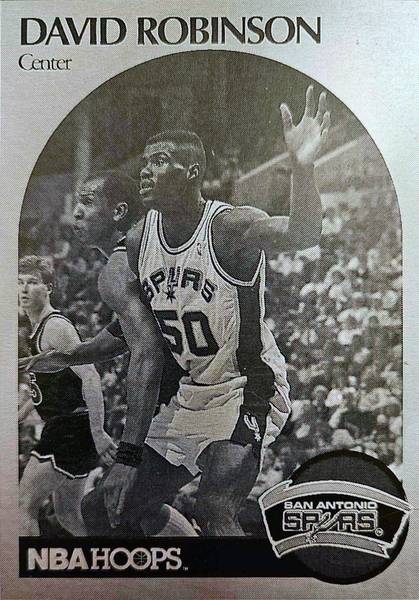
The metal cards don’t reach production
As we know, the metal cards never progressed past the prototype stage. There were two reasons for this decision.
Firstly, trading cards are often collected by kids and giving away pieces of aluminium sheets to kids was decided to be too dangerous. The sharp corners and edges could easily harm if mishandled.
Secondly, the process was not inexpensive and the cost-benefit analysis didn’t add up for Hoops.
So, while the cardboard prototypes reached production as 91-92 Hoops with minor changes (aside from the photos used and player bios), the aluminium cards were not to be.
Metal cards that did make it to production
This wasn’t the end of metal trading card work for GM Nameplate, however.
In 1994 GM produced a boxed single card in silver and gold coloured metal for Skybox for their Harley Davidson box set. The card features the 1914 Model 10-E Harley Davidson motorcycle known as the Silent Gray Fellow.
Leo was also involved in the production of these pieces and owns the copies shown below.
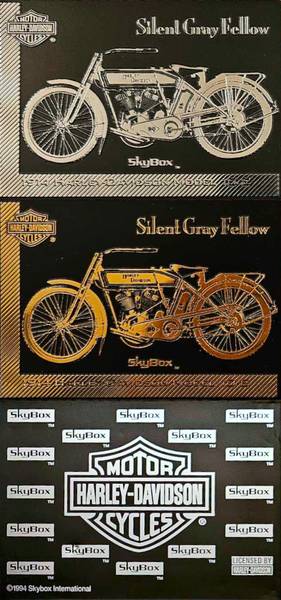
Buying Michael Jordan Hoops Metal cards
We’ve heard from Leo that the print run on the metal prototypes is less than 200. This means there aren’t many changing hands but it can’t hurt to keep an eye out for listings online. I’ve seen a couple turn up for sale over the years so take a look at the pages linked below.
Back in 2011 I connected with Chip Leakes who shared his interesting story of interviewing for a rep position at GM where he was gifted a Jordan Hoops Metal Prototype by the president.
The Hoops produced Jordan cardboard prototype - with ‘PROTOTYPE’ printed on the reverse is thankfully always readily available if you’re looking to add a copy to your collection.
As for the Jordan Hoops prototype with no prototype designation - there have been some sales listings around recently.
Currently eBay has single listing of the Jordan cardboard prototype without the reverse ‘PROTOTYPE’ printed with an asking price of $10k. The same seller has a number of other players with no prototype printed in the $250 realm.
A further no-prototype set of 6 listing including the Jordan is listed at $799.99 on eBay.
I hope you enjoyed that dive into this piece of Jordan cards history and I am very grateful and thankful to Leo for the time he took to share his story and artefacts with us. Leo’s first-hand knowledge, production process information and print run information really give us as collectors invaluable insights. So, thank you to Leo.
If you own any of these cards and would like to share about them please do write in. I’m particularly keen to hear from anyone who owns or knows of any copies which have been autographed.



